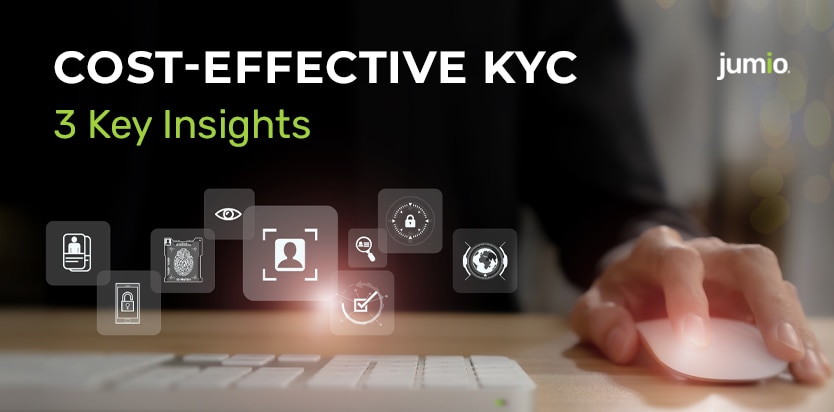
Did you know that Know Your Customer (KYC) procedures can cost around 3% of a bank’s total operational cost base? This is a significant expense, but the penalty for having an insufficient KYC program is even higher.
Increasing and ever-changing Anti-Money Laundering (AML) regulations consistently raise the bar for financial institutions, and failure to comply can lead to steep fines, possible sanctions and reputational damage. Meanwhile, banks are under tremendous pressure to reduce operational costs and increase conversions through a smooth customer onboarding experience.
So how do you stay abreast of the law while keeping operational and compliance costs down and also grow your customer base? Four industry leaders from Jumio, GoodBank, Moolahgo and moomoo Singapore recently shared their perspectives in a panel discussion. Here are three key insights.
1. It’s not about surviving. It’s about thriving.
Many businesses are cutting costs to sustain profitability in the face of declining revenue and the uncertainty that lies ahead. They are looking at their own operations to see how to optimize their processes across functions and make them more effective.
According to Steven Chau, Strategic Accounts Director APAC for Jumio, businesses need to consolidate and streamline technologies and processes to reduce costs, but at the same time they must find more innovative ways to deliver customer-centric service.
For digital businesses, electronic Know Your Customer (eKYC) is essential to protect their online ecosystem from fraudsters and to comply with regulatory requirements. But most eKYC solutions are limited in scope, forcing companies to purchase, integrate and maintain dozens of different point solutions to meet all their identity verification requirements across the end-user journey. This approach puts a huge burden on organizations in terms of time, resources and money. This is why so many companies are now turning to end-to-end identity proofing platforms with orchestration.
Orchestration allows companies to design a risk-based KYC workflow to provide a frictionless experience for their legitimate customers. The result is higher customer conversions without compromising on security.
On-Demand Webinar with Jumio and Seamless
Reduce Operational and Compliance Costs Whilst Growing Your Customer Base
2. Take into consideration customer experience when designing your KYC onboarding workflow. Don’t reinvent the wheel.
During the panel discussion, Rogelio Umali, Chief Technology Officer, Goodbank, described the steps for tailoring the KYC workflow to fit the buyer persona. “The first is to identify the persona. The second is to define the customer journey map.” The next steps involve creating a prototype, building the workflow, conducting an initial product release to test the market and seeking user feedback before carrying out the actual launch.
Chau also added that the best way to assess which onboarding process to deploy is to download the tool or app and then check out how it performs with users through their feedback and comments. “Those comments are the best market research, because they actually tell you what the customers feel and what their experiences have been.”
Better yet, download the tool or app to experience for yourself how it works. “Don’t worry about whether [the app] is perfect. Would you actually feel good about using it yourself?”
For instance, asking a user to take a corroborating selfie during a liveness check will be more natural than requesting them to turn their head.
3. Strategic outsourcing helps businesses to be more cost-effective.
Buy or build is a common question that needs to be addressed when planning your KYC process. Putting together an in-house KYC team is not an easy task, especially for small startups.
John Hakim, Founder & CEO, Moolahgo, shared that there is no right or wrong way. “When you’re small, when you’re a startup, that’s when it’s the best time to try out and fail, [to] see which model actually works.” He added, “You’re obviously not going to invest in a huge compliance department right from day one. You want to be able to start off small, and then scale up according to your business.”
Umali agreed. “There’s a lot of trial and error in this to find the sweet spot — to build in-house or to contract [to] a third party,” especially if the company does not have an in-house IT team. The scale and speed to launch is another consideration. For instance in the Philippines, he noted that the sweet spot to outsource eKYC is if your business has fewer than 100,000 users, and to consider building your in-house team if your user base grows to over 3 million.
Gavin Chia, Managing Director, moomoo Singapore, added that there are two considerations that his team is constantly looking at when deciding whether to outsource: cost and time. “The cost of actually setting up the whole infrastructure. And the time that will be taken to allow us to align with the rules and regulations of the Monetary Authority of Singapore (MAS).”
Chau also shared that it really depends on a business’ vision. “It’s taking the time to think ahead to ask, where do we want to be? What do we want that experience to be?” This, he said, will help determine whether building in-house or outsourcing would better serve the business’ needs and growth.
For more insights into how you can reduce operational and compliance costs whilst growing your customer base, check out the webinar on demand here.
